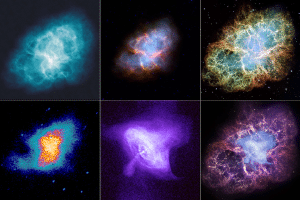Post
What You Get
is
What You See
4 April 2013
 Credits listed below.
Credits listed below.The Crab Nebula is the remnant of a supernova that exploded in 1054. You can see an image of it above. Actually you can see several images of it. These images look very different from each other because they were observed by different instruments, that each detect different ranges of wavelengths of light. Just as our eyes are capable of observing a particular range of wavelengths, each instrument can only observe a particular range of wavelengths. Comparing the images, it is clear that the wavelengths we observe greatly determines what features we see.
The source of these particular images are as follows:
Top Row (left to right):
- Radio image taken by the VLA
- Infrared image taken by the Spitzer space telescope
- Visible Light image taken by the Hubble telescope
Bottom Row (left to right):
- Ultraviolet image taken by Astro-1
- X-ray image taken by the Chandra space telescope
- A composite false-color image of infrared (purple), visible (red, yellow) and x-ray (blue)
With the exception of the visible light image, we can’t see the wavelengths observed, so the image is created using “false-colors”, with different wavelengths assigned various colors. Colors can be chosen to make certain features stand out, or simply because it makes the image look striking. The last image, for example, is so striking it was chosen for the cover of my book.
But that’s another story.